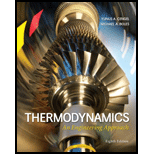
(a)
The equilibrium constant obtained from the equilibrium reaction at 298 K.
(a)
Answer to Problem 24P
The equilibrium constant obtained from the equilibrium reaction at 298 K is
Explanation of Solution
Express the standard-state Gibbs function change.
Here, the Gibbs function of components
Write the equation to calculate the natural logarithms of equilibrium constant for the chemical equilibrium of ideal-gas mixtures.
Here, universal gas constant is
Write the equation to calculate the equilibrium constant for the chemical equilibrium of ideal-gas mixtures.
Conclusion:
From the equilibrium reaction, the values of
Refer to Table A-26; obtain the values of
Substitute 1 for
Substitute
Substitute
Thus, the equilibrium constant obtained from the equilibrium reaction at 298 K is
The value obtained for equilibrium constant at 298 K from the definition of the equilibrium constant is
(b)
The equilibrium constant obtained from the equilibrium reaction at 1800K.
(b)
Answer to Problem 24P
The equilibrium constant obtained from the equilibrium reaction at 1800Kis
Explanation of Solution
Write the expression to obtain standard-state Gibbs function change.
Here, the Gibbs function of components
Write the equation to calculate the natural logarithms of equilibrium constant for the chemical equilibrium of ideal-gas mixtures.
Here, universal gas constant is
Write the equation to calculate the equilibrium constant for the chemical equilibrium of ideal-gas mixtures.
Conclusion:
From the equilibrium reaction, the values of
Refer Table A-26, obtain the values of
Refer Table A-22, obtain the value of
Refer Table A-22, obtain the value of
Refer Table A-19, obtain the value of
Refer Table A-19, obtain the value of
Refer Table A-23, obtain the value of
Refer Table A-23, obtain the value of
Substitute 1 for
Substitute
Substitute
Thus, the equilibrium constant obtained from the equilibrium reaction at 1800Kis
The value obtained for equilibrium constant at 1800K from the definition of the equilibrium constant is
Want to see more full solutions like this?
Chapter 16 Solutions
Thermodynamics: An Engineering Approach
- Solve, use engineering economic tablesarrow_forwardplease show all workarrow_forwardUSE MATHLAB WITH CODES Estimate the damping ratio, stiffness, natural frequency, and mass of the SDOF system. Please use a MATHLAB with CODES and no negative damping ratio. Data Set 1:Time(s) Data Set 1:top1(g) Data Set 1:bottom(g)0 0.002593181 0.007262860.01 0.011367107528507709 -0.0015110660.02 0.007467585 -0.0058980290.029999999999999999 0.004542943 0.0028758970.040000000000000001 0.018678712689042091 -0.0019985060.050000000000000003 0.004542943 0.0009261360.059999999999999998 0.014779189431130886 -0.0068729090.070000000000000007 0.004055502 -0.0088226710.080000000000000002 0.008442465 -0.0015110660.089999999999999997 0.011854547366917134 -0.0039482670.10000000000000001 0.007467585 0.0058005390.11 0.004055502 0.0043382180.12 0.010392226334810257 0.0019010160.13 0.010392226334810257 -0.001998506% 0.14000000000000001 0.016728950301647186 0.0048256580.14999999999999999 0.007955025…arrow_forward
- Provide an example of at least five features produced by a certain machining process (for example, a keyway to accommodate a key iarrow_forwardHow to draw a gam from the data of the subject's readings three times and difficulties in drawing a gam Material Name: Machinery Theory I'm a vehicle engineering student. Please describe details about gam in addition the law gam: 1-tangent cam with reciprocating roller follower. 2-circular arc cam with flat-faced follower.arrow_forwardhand-written solutions only pleasearrow_forward
- C A cylindrical piece of steel 38 mm (1½ in.) in diameter is to be quenched in moderately agi- tated oil. Surface and center hardnesses must be at least 50 and 40 HRC, respectively. Which of the following alloys satisfy these requirements: 1040, 5140, 4340, 4140, and 8640? Justify your choice(s).arrow_forwardUsing the isothermal transformation diagram for a 1.13 wt% C steel alloy (Figure 10.39), determine the final microstructure (in terms of just the microconstituents present) of a small specimen that has been subjected to the following time-temperature treatments. In each case assume that the specimen begins at 920°C (1690°F) and that it has been held at this temperature long enough to have achieved a complete and homogeneous austenitic structure. (a) Rapidly cool to 250°C (480°F), hold for 103 s, then quench to room temperature. (b) Rapidly cool to 775°C (1430°F), hold for 500 s, then quench to room temperature. (c) Rapidly cool to 400°C (750°F), hold for 500 s, then quench to room temperature. (d) Rapidly cool to 700°C (1290°F), hold at this temperature for 105 s, then quench to room temperature. (e) Rapidly cool to 650°C (1200°F), hold at this temperature for 3 s, rapidly cool to 400°C (750°F), hold for 25 s, then quench to room temperature. (f) Rapidly cool to 350°C (660°F), hold for…arrow_forwardHow to solve this?arrow_forward
 Elements Of ElectromagneticsMechanical EngineeringISBN:9780190698614Author:Sadiku, Matthew N. O.Publisher:Oxford University Press
Elements Of ElectromagneticsMechanical EngineeringISBN:9780190698614Author:Sadiku, Matthew N. O.Publisher:Oxford University Press Mechanics of Materials (10th Edition)Mechanical EngineeringISBN:9780134319650Author:Russell C. HibbelerPublisher:PEARSON
Mechanics of Materials (10th Edition)Mechanical EngineeringISBN:9780134319650Author:Russell C. HibbelerPublisher:PEARSON Thermodynamics: An Engineering ApproachMechanical EngineeringISBN:9781259822674Author:Yunus A. Cengel Dr., Michael A. BolesPublisher:McGraw-Hill Education
Thermodynamics: An Engineering ApproachMechanical EngineeringISBN:9781259822674Author:Yunus A. Cengel Dr., Michael A. BolesPublisher:McGraw-Hill Education Control Systems EngineeringMechanical EngineeringISBN:9781118170519Author:Norman S. NisePublisher:WILEY
Control Systems EngineeringMechanical EngineeringISBN:9781118170519Author:Norman S. NisePublisher:WILEY Mechanics of Materials (MindTap Course List)Mechanical EngineeringISBN:9781337093347Author:Barry J. Goodno, James M. GerePublisher:Cengage Learning
Mechanics of Materials (MindTap Course List)Mechanical EngineeringISBN:9781337093347Author:Barry J. Goodno, James M. GerePublisher:Cengage Learning Engineering Mechanics: StaticsMechanical EngineeringISBN:9781118807330Author:James L. Meriam, L. G. Kraige, J. N. BoltonPublisher:WILEY
Engineering Mechanics: StaticsMechanical EngineeringISBN:9781118807330Author:James L. Meriam, L. G. Kraige, J. N. BoltonPublisher:WILEY





